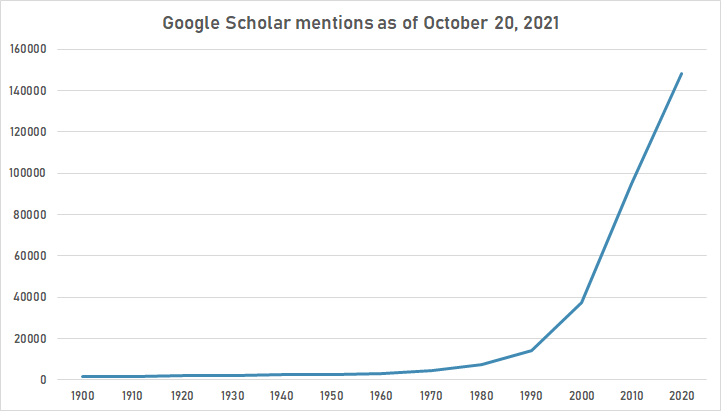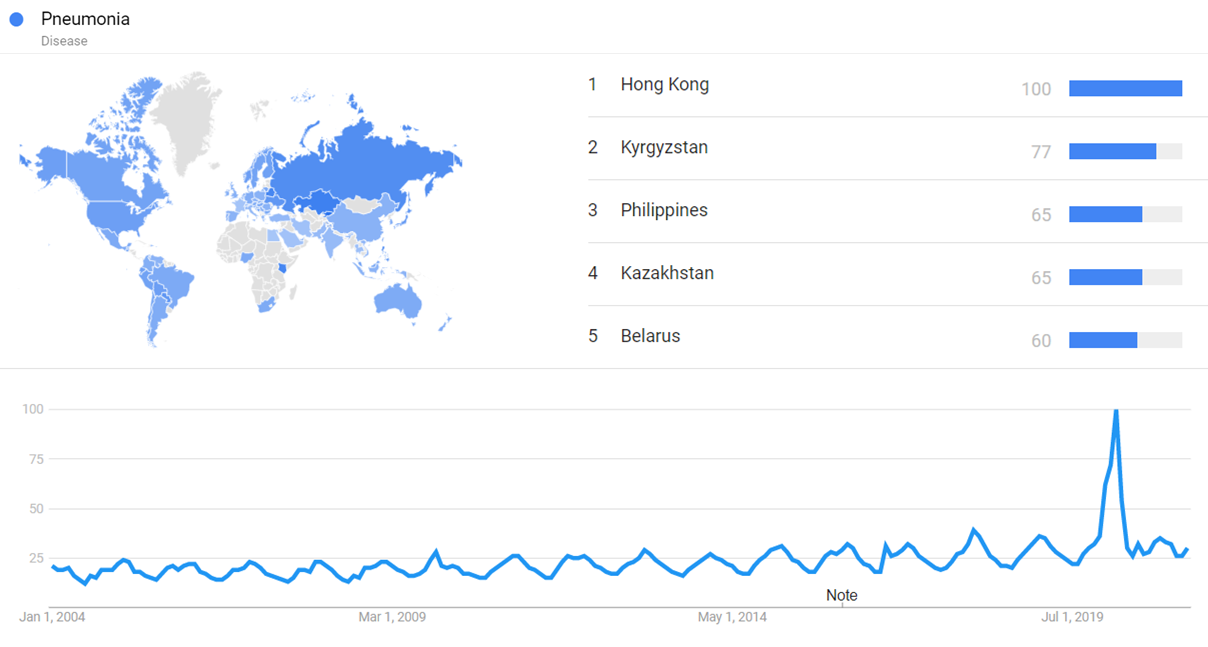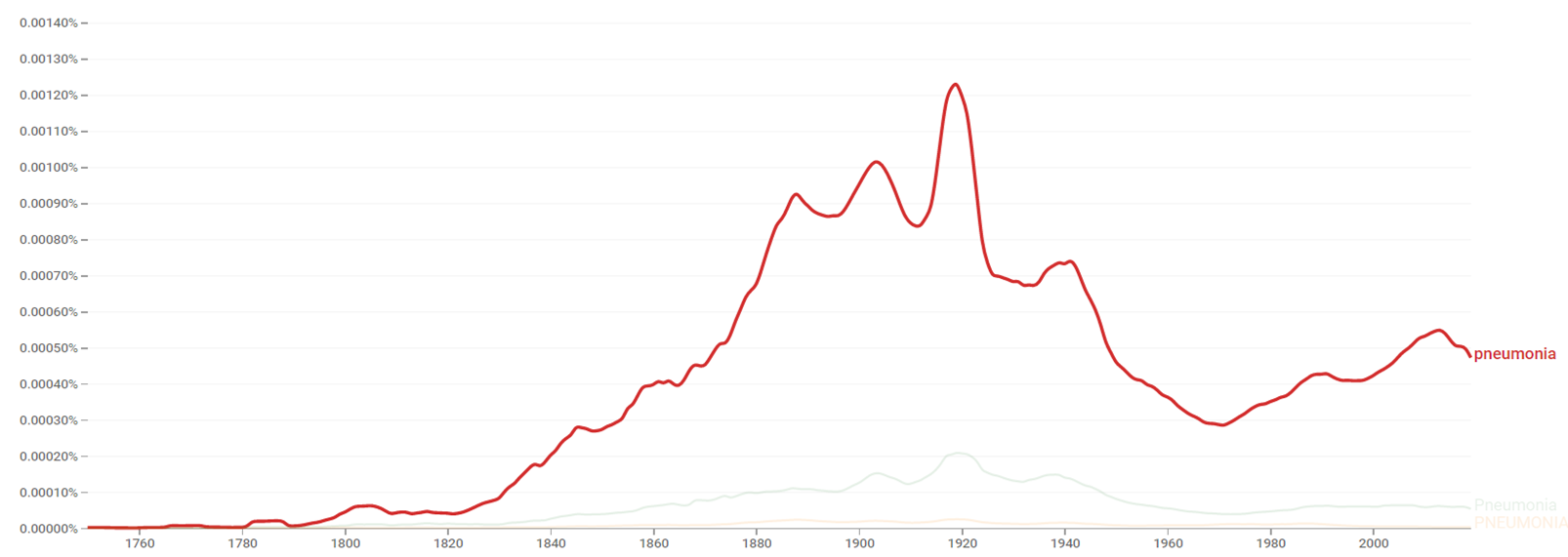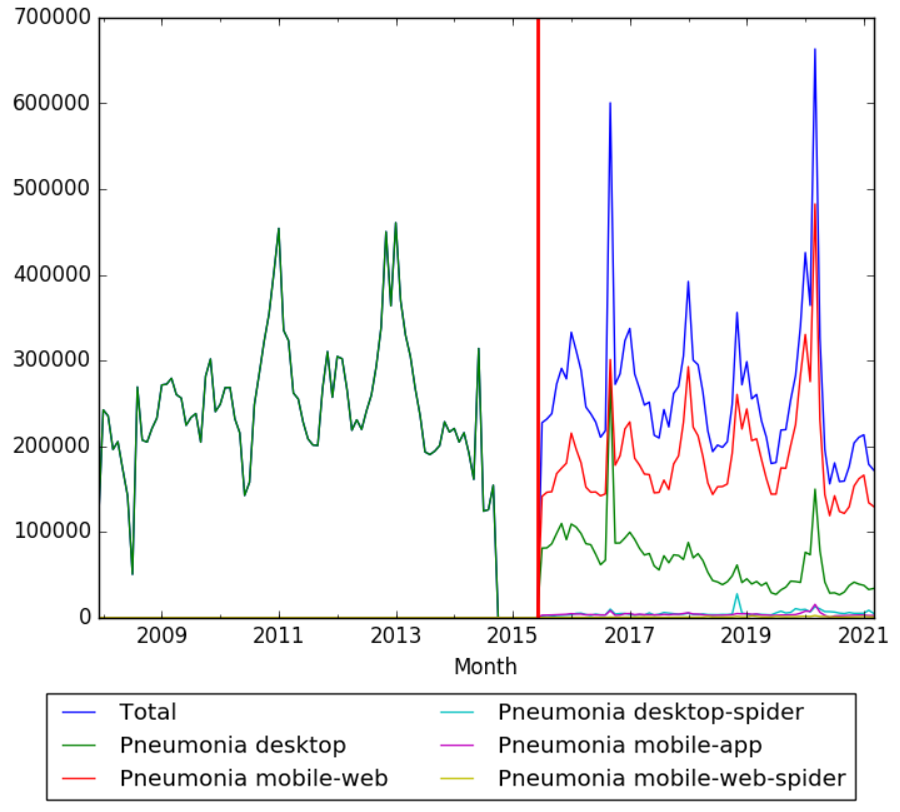Timeline of pneumonia
This is a timeline of pneumonia, attempting to describe important events in the history of the disease.
Big picture
| Time period | Development summary |
|---|---|
| 19th century | The 1870s and early 1880s mark the onset of the discovery of infectious agents of disease, whereas the late 1880s and early 1890s witness the beginning of the medical attack on such pathogens through applied humoral immunology.[1] During the late 1800s through the early 1900s, pneumonia stands as the leading cause of death due to infectious disease and the third leading cause of death overall.[2] |
| 20th century | Throughout the century, the use of antibiotics as a treatment strategy continues. However, widespread overuse of antibiotics would lead to the creation of penicillin-resistant strains of Streptococcus pneumoniae.[2] From 1915 to 1945, the chemical structure and antigenicity of the pneumococcal capsular polysaccharide, its association with virulence, and the role of bacterial polysaccharides in human disease are explained.[3] Up until the early 1940s, textbooks of medicine recognize that pneumonia could present only as lobar pneumonia or bronchopneumonia, with the small residuum dubbed as ‘‘unresolved’’.[4] The first vaccine is introduced in 1977. In the 1980s, the classification of pneumonia based on lists of different pathogens is abandoned in favour of a more practical classification that helps to guide investigation, management and therapy.[4] |
| 21st century | Today, pneumonia affects approximately 450 million people globally (7% of the population) and results in about 4 million deaths per year.[5][6] The World Health Organization estimates that one in three newborn infant deaths is due to pneumonia.[7] |
Full timeline
| Year | Event type | Details | Location |
|---|---|---|---|
| 1875 | Scientific deveopment | German-Swiss pathologist Edwin Klebs is the first to observe bacteria in the airways of persons having died of pneumonia.[8] | Germany |
| 1881 | Scientific deveopment | Bacterium Streptococcus pneumonia, one of the most common causes of pneumonia throughout the world, is discovered independently by French microbiologist Louis Pasteur, and American microbiologist George Miller Sternberg, after both identified lancet-shaped bacteria in saliva. It is named Microbe septicemique du salive by Pasteur and Micrococcus pasteuri by Sternberg.[9][10][11] | France, United States |
| 1883 | Scientific deveopment | Friedlander and Talamon first dscribe the association between the pneumococcus and lobar pneumonia.[3][12][13][14] | |
| 1884 | Scientific development | The gram stain is developed, putting an end to confusion between pneumococcal pneumonia with other types of pneumonia.[3] | |
| 1886 | Scientific development | The organism previously named by Pasteur and Sternberg is referred to as pneumococcus by German physician Albert Fraenkel because of its propensity to cause pulmonary disease.[9][15][9] | |
| 1892 | Scientific development | Canadian physician William Osler writes of pneumonia, "It is a self-limited disease, and has its course uninfluenced in any way by medicine". | |
| 1893 | Scientific deveopment | The first attempt to treat pneumococcal pneumonia with rabbit serum (generated through inoculating rabbits with pneumococci) takes place in Germany.[1] | Germany |
| 1911 | Medical deveopment | Efforts to develop effective pneumococcal vaccines begin.[3] Whole-cell pneumococcal vaccines are tested among gold miners of South Africa.[16][12] | South Africa |
| 1911 | Scientific development | Morganroth and Levy show that a quinine derivative, ethylhydrocupreine (also known as optochin), inhibits the growth of pneumococci but not of clinically related organisms.[9] | |
| 1913 | Medical deveopment | Antipneumococcal serum therapy becomes available, being able to reduce mortality from 25% to 7.5%, if given early in disease progression. However, this treatment method is slow, costly, and time-consuming at the time.[2] | |
| 1928 | Scientific development | Scottish microbiologist Alexander Fleming, a Professor of Bacteriology at St Mary’s Hospital in London, discovers penicillin after sorting through some petri dishes containing a bacteria called staphylococcus, which causes boils, sore throats and abscesses. Flemming discovers killed baceria in one dish contaning a blob of mold on it.[17][18] | United Kingdom |
| 1929 | Scientific deveopment | Scottish physician Alexander Fleming discovers the antibacterial properties of the fungus-derived substance that later comes to be called penicillin.[19][20][21][9] | Unitd Kingdom |
| 1920s | Medical deveopment | Type I specific antipneumococcal serotherapy proves efficacious in large hospitals of the United States.[1] | United States |
| 1930 | Scientific development | William S. Tillett and Thomas Francis discover that purified pneumococcal polysaccharides could induce specific anti-capsular antibodies in humans.[22] | United States |
| 1939 | Medical deveopment | Antibacterial agent, sulfapyridine, the first effective antipneumococcal sulfonamide, is introduced in the United States, representing the emerging chemotherapeutic revolution as applied to pneumonia.[1][2][23][24][25] | United States |
| 1939 | Scientific deveopment | French-born American microbiologist René Dubos discovers the first naturally occurring antimicrobial compound with demonstrable activity in vitro against a bacterial pathogen. This compound is named gramicidin, with demonstrated activity against streptococcus pneumoniae.[9] | United States |
| 1940 | Scientific development | More than 80 serotypes of pneumococci are described by the time.[3][26][27][12] | |
| 1942 | Medical deveopment | Antibiotic penicillin begins to be used to treat infections.[28][2] | |
| 1945 | Medical development | Macleod, Heidelberger and colleagues show that a 4-valent pneumococcal polysaccharide vaccine (PPV4) containing serotypes 1, 2, 5 and 7 is protective against pneumococcal disease caused by the same serotypes.[29] | |
| 1947 | Medical deveopment | Kaufman demonstrates the safety and efficacy of 2-valent and 3-valent pneumococcal polysaccharide vaccines.[30] | |
| Late 1960s | Medical deveopment | Efforts are again made to develop a polyvalent pneumococcal vaccine.[3] | |
| 1974 | Scientific development | Pneumococcus is given its present name, Streptococcus pneumoniae, primarily on the basis of its characteristic growth as chains of cocci in liquid media.[9][15] | |
| 1977 | Medical deveopment | The pneumococcal polysaccharide vaccine (PPV), a vaccine to protect against bacterial pneumonia, is first developed. However, this vaccine only protects against a limited number of Streptococcal serotypes.[2][3][31][16][32][33] | United States |
| 1977 | Vaccination against Streptococcus pneumoniae in adults begins.[34] | ||
| 1980s | Scientific development | The classification of pneumonia based on lists of different pathogens is abandoned in favour of a more practical classification that helps to guide investigation, management and therapy: CAP, 9 hospital-acquired (or nosocomial) pneumonia, and pneumonia in the immuno- compromised host.[4] | |
| 1983 | Medical deveopment | 23-valent polysaccharide vaccine is licensed.[3][33][35][36] | |
| 1988 | Medical deveopment | Vaccination of infants against Haemophilus influenzae type B begins, leading to a dramatic decline in cases shortlythereafter.[37] | |
| 2000 | Medical deveopment | The pneumococcal conjugate vaccine (PCV), is introduced, offering protection against many more serotypes, including several strains that were resistant to antibiotics.[2][3][33] | |
| 2000 | Medical deveopment | Vaccination against Streptococcus pneumoniae in children begins.[34] | |
| 2007 | Program launch | Five countries (Canada, Italy, Norway, Russia, the United Kingdom), and the Bill & Melinda Gates Foundation commit US$1.5 billion to launch the first Advance Market Commitment (AMC) with the purpose of accelerating access to vaccines against pneumococcal disease.[38] | Canada, Italy, Norway, Russia, United Kingdom |
| 2008 | Scientific development | The definition of penicillin resistance is modified such that a much larger proportion of pneumococci are now considered susceptible to penicillin.[3] | |
| 2008 | Epidemiology | Pneumonia occurred in approximately 156 million children (151 million in the developing world and 5 million in the developed world) in the year.[5] | |
| 2009 | Medical deveopment | A 10-valent Pneumococcal conjugate vaccine is licensed for the vaccination of children.[39] | |
| 2009 | The first World Pneumonia Day is held on November 2.[40][41][42] | ||
| 2010 | Medical deveopment | A 13-valent Pneumococcal conjugate vaccine is licensed.[3][39] | |
| 2010 | Medical development | Pfizer, the manfacturer of PVC7, replaces it with an extended version, PCV13.[39][43][44] | United States |
| 2010 | Epidemiology | Worldwide, pneumonia resulted in 1.3 million deaths, or 18% of all deaths in those under five years, of which 95% occurred in the developing world during the year.[5][45][46] | |
| 2011 | Scientific development | 92 serotypes of streptococcus pneumoniae are documented by the time.[3][47][48] | |
| 2011 | Epidemiology | Pneumonia reveals to be the most common reason for admission to the hospital after an emergency department visit in the United States for infants and children.[49] | United States |
| 2013 | Medical development | United States FDA approves use of Prevnar 13 vaccine in older children and teens (6-17 years).[50] | United States |
| 2016 | Study | A large trial studying the use of vitamin D to prevent pneumonia in children, finds no effect.[51][52][53] |
Numerical and visual data
Google Scholar
The following table summarizes per-year mentions on Google Scholar as of October 20, 2021.
| Year | pneumonia |
|---|---|
| 1900 | 1,390 |
| 1910 | 1,550 |
| 1920 | 2,020 |
| 1930 | 1,940 |
| 1940 | 2,490 |
| 1950 | 2,770 |
| 1960 | 3,030 |
| 1970 | 4,530 |
| 1980 | 7,500 |
| 1990 | 14,000 |
| 2000 | 37,300 |
| 2010 | 94,800 |
| 2020 | 148,000 |

Google Trends
The chart below shows Google Trends data for Pneumonia (Disease), from January 2004 to April 2021, when the screenshot was taken. Interest is also ranked by country and displayed on world map.[54]

Google Ngram Viewer
The chart below shows Google Ngram Viewer data for Pneumonia, from 1750 to 2019.[55]

Wikipedia Views
The chart below shows pageviews of the English Wikipedia article Pneumonia, on desktop from December 2007, and on mobile-web, desktop-spider, mobile-web-spider and mobile app, from July 2015; to March 2021. A data gap observed from October 2014 to June 2015 is the result of Wikipedia Views failure to retrieve data.[56]

Meta information on the timeline
How the timeline was built
The initial version of the timeline was written by User:Sebastian.
Funding information for this timeline is available.
Feedback and comments
Feedback for the timeline can be provided at the following places:
- FIXME
What the timeline is still missing
Timeline update strategy
See also
External links
References
- ↑ 1.0 1.1 1.2 1.3 Podolsky, Scott H. "The Changing Fate of Pneumonia as a Public Health Concern in 20th-Century America and Beyond". doi:10.2105/AJPH.2004.048397. PMC 1449499. PMID 16257952.
{{cite journal}}: Cite journal requires|journal=(help) - ↑ 2.0 2.1 2.2 2.3 2.4 2.5 2.6 "Pneumonia History". news-medical.net. Retrieved 9 January 2019.
- ↑ 3.00 3.01 3.02 3.03 3.04 3.05 3.06 3.07 3.08 3.09 3.10 3.11 "Pneumococcal Disease" (PDF). cdc.gov. Retrieved 9 January 2019.
- ↑ 4.0 4.1 4.2 Blasi, Francesco; Aliberti, Stefano; Pappalettera, Maria; Tarsia, Paolo. "100 years of respiratory medicine: Pneumonia". doi:10.1016/j.rmed.2007.02.016.
{{cite journal}}: Cite journal requires|journal=(help) - ↑ 5.0 5.1 5.2 Ruuskanen O, Lahti E, Jennings LC, Murdoch DR (April 2011). "Viral pneumonia". Lancet. 377 (9773): 1264–75. doi:10.1016/S0140-6736(10)61459-6. PMID 21435708.
- ↑ Lodha R, Kabra SK, Pandey RM (June 2013). "Antibiotics for community-acquired pneumonia in children". The Cochrane Database of Systematic Reviews. 6 (6): CD004874. doi:10.1002/14651858.CD004874.pub4. PMID 23733365.
- ↑ Garenne M, Ronsmans C, Campbell H (1992). "The magnitude of mortality from acute respiratory infections in children under 5 years in developing countries". World Health Statistics Quarterly. Rapport Trimestriel De Statistiques Sanitaires Mondiales. 45 (2–3): 180–91. PMID 1462653.
- ↑ Klebs E (1875-12-10). "Beiträge zur Kenntniss der pathogenen Schistomyceten. VII Die Monadinen" [Signs for Recognition of the Pathogen Schistomyceten]. Arch. Exp. Pathol. Pharmakol. 4 (5/6): 40–88.
- ↑ 9.0 9.1 9.2 9.3 9.4 9.5 9.6 Wqatson, David A.; Musher, Daniel M.; Jacobson, James W.; Verhoef, Jan. "A Brief History of the Pneumococcus in Biomedical Research: A Panoply of Scientific Discovery" (PDF). nih.gov. Retrieved 9 January 2019.
- ↑ Fry, Michael. Landmark Experiments in Molecular Biology.
- ↑ Marble, Sanders. Builders of Trust.
- ↑ 12.0 12.1 12.2 Gupta, Piyush; Menon, PSN; Ramji, Siddarth; Lodha, Rakesh. PG Textbook of Pediatrics: Volume 2: Infections and Systemic Disorders.
- ↑ A system of medicine, Volume 5.
- ↑ Miller Sternberg, George. A Text-book of Bacteriology.
- ↑ 15.0 15.1 Plotkin, Stanley A.; Orenstein, Walter; Offit, Paul A. Vaccines E-Book: Expert Consult - Online and Print.
- ↑ 16.0 16.1 Infections of the Central Nervous System (Michael W. Scheld, Richard J. Whitley, Christina M. Marra ed.).
- ↑ Newell-McGloughlin, Martina; Re, Edward. The Evolution of Biotechnology: From Natufians to Nanotechnology.
- ↑ "Ten important moments in the history of antibiotic discovery". correctiv.org. Retrieved 29 March 2018.
- ↑ Sickness and Health in America: Readings in the History of Medicine and Public Health (Judith Walzer Leavitt, Ronald L. Numbers ed.).
- ↑ Aneja, K. R. Experiments in Microbiology, Plant Pathology and Biotechnology.
- ↑ Waller, John. Fabulous Science: Fact and Fiction in the History of Scientific DiscoveryFabulous Science: Fact and Fiction in the History of Scientific Discovery.
- ↑ Wang, Yang; Li, Jingxin; Wang, Yuxiao; Gu, Wei; Zhu, Fengcai (2018-04-03). "Effectiveness and practical uses of 23-valent pneumococcal polysaccharide vaccine in healthy and special populations". Human Vaccines & Immunotherapeutics. 14 (4): 1003–1012. doi:10.1080/21645515.2017.1409316.
- ↑ Bhattacharjee, Mrinal K. Chemistry of Antibiotics and Related Drugs.
- ↑ Ward, John W.; Warren, Christian. Silent Victories: The History and Practice of Public Health in Twentieth-Century America.
- ↑ Saxena, Sanjai. Applied Microbiology.
- ↑ Gupta, Piyush; Menon, PSN; Ramji, Siddarth; Lodha, Rakesh. PG Textbook of Pediatrics: Volume 2: Infections and Systemic Disorders.
- ↑ "Pneumococcal Disease". cdc.gov. Retrieved 31 January 2019.
- ↑ Oxford Handbook of Infectious Diseases and Microbiology. OUP Oxford. 2009. p. 56. ISBN 978-0-19-103962-1.
- ↑ Wang, Yang; Li, Jingxin; Wang, Yuxiao; Gu, Wei; Zhu, Fengcai (3 April 2018). "Effectiveness and practical uses of 23-valent pneumococcal polysaccharide vaccine in healthy and special populations". Human Vaccines & Immunotherapeutics. 14 (4): 1003–1012. doi:10.1080/21645515.2017.1409316.
- ↑ A review of selected Federal vaccine and immunization policies : based on case studies of pneumococcal vaccine.
- ↑ Acute Respiratory Infections (Wei Shen Lim ed.).
- ↑ Health Promotion and Disease Prevention in Clinical Practice (Steven H. Woolf, Steven Jonas, Evonne Kaplan-Liss ed.).
- ↑ 33.0 33.1 33.2 Parthasarathy, A. Partha's Immunization Digest.
- ↑ 34.0 34.1 Whitney CG, Farley MM, Hadler J, Harrison LH, Bennett NM, Lynfield R, Reingold A, Cieslak PR, Pilishvili T, Jackson D, Facklam RR, Jorgensen JH, Schuchat A (May 2003). "Decline in invasive pneumococcal disease after the introduction of protein-polysaccharide conjugate vaccine". The New England Journal of Medicine. 348 (18): 1737–46. doi:10.1056/NEJMoa022823. PMID 12724479.
{{cite journal}}: Unknown parameter|displayauthors=ignored (|display-authors=suggested) (help) - ↑ Bacterial Polysaccharides: Current Innovations and Future Trends (Matthias Ullrich ed.).
- ↑ Jong, Elaine C.; Stevens, Dennis L. Netter's Infectious Diseases E-Book.
- ↑ Adams WG, Deaver KA, Cochi SL, Plikaytis BD, Zell ER, Broome CV, Wenger JD (January 1993). "Decline of childhood Haemophilus influenzae type b (Hib) disease in the Hib vaccine era". JAMA. 269 (2): 221–26. doi:10.1001/jama.1993.03500020055031. PMID 8417239.
{{cite journal}}: Unknown parameter|displayauthors=ignored (|display-authors=suggested) (help) - ↑ "GAVI partners fulfill promise to fight pneumococcal disease". gavi.org. Retrieved 1 June 2018.
- ↑ 39.0 39.1 39.2 Community-Acquired Pneumonia: European Respiratory Monograph (Stefano Aliberti, James D. Chalmers, Mathias W. Pletz ed.).
- ↑ Chase's Calendar of Events 2019: The Ultimate Go-to Guide for Special Days, Weeks and Months.
- ↑ "PNEUMONIA" (PDF). stoppneumonia.org. Retrieved 31 January 2019.
- ↑ "World Pneumonia Day". who.int. Retrieved 31 January 2019.
- ↑ "The Newly Licensed Pneumococcal Conjugate Vaccine: Questions—and Answers: Page 2 of 2". pediatricsconsultantlive.com. Retrieved 31 January 2019.
- ↑ Community-Acquired Pneumonia: European Respiratory Monograph (Stefano Aliberti, James D. Chalmers, Mathias W. Pletz ed.).
- ↑ Singh V, Aneja S (March 2011). "Pneumonia – management in the developing world". Paediatric Respiratory Reviews. 12 (1): 52–59. doi:10.1016/j.prrv.2010.09.011. PMID 21172676.
- ↑ Liu L, Johnson HL, Cousens S, Perin J, Scott S, Lawn JE, Rudan I, Campbell H, Cibulskis R, Li M, Mathers C, Black RE (June 2012). "Global, regional, and national causes of child mortality: an updated systematic analysis for 2010 with time trends since 2000". Lancet. 379 (9832): 2151–61. doi:10.1016/S0140-6736(12)60560-1. PMID 22579125.
- ↑ Weinberger, Daniel M.; Malley, Richard; Lipsitch, Marc. "Serotype replacement in disease following pneumococcal vaccination: A discussion of the evidence". doi:10.1016/S0140-6736(10)62225-8. PMID 21492929.
{{cite journal}}: Cite journal requires|journal=(help) - ↑ Leung, Marcus H.; Bryson, Kevin; Freystatter, Kathrin; Pichon, Bruno; Edwards, Giles; Charalambous, Bambos M.; Gillespiea, Stephen H. "Sequetyping: Serotyping Streptococcus pneumoniae by a Single PCR Sequencing Strategy". doi:10.1128/JCM.06384-11. PMID 22553238.
{{cite journal}}: Cite journal requires|journal=(help) - ↑ Weiss AJ, Wier LM, Stocks C, Blanchard J (June 2014). "Overview of Emergency Department Visits in the United States, 2011". HCUP Statistical Brief #174. Rockville, MD: Agency for Healthcare Research and Quality. Archived from the original on 3 August 2014.
{{cite web}}: Unknown parameter|deadurl=ignored (|url-status=suggested) (help) - ↑ "PFIZER RECEIVES FDA APPROVAL FOR THE USE OF PREVNAR 13 IN VACCINE-NAIVE CHILDREN AND ADOLESCENTS AGED 6 YEARS THROUGH 17 YEARS FOR THE PREVENTION OF INVASIVE PNEUMOCOCCAL DISEASE". pfizer.com. Retrieved 3 June 2020.
- ↑ Yakoob MY, Salam RA, Khan FR, Bhutta ZA (November 2016). "Vitamin D supplementation for preventing infections in children under five years of age". The Cochrane Database of Systematic Reviews. 11: CD008824. doi:10.1002/14651858.CD008824.pub2. PMID 27826955.
- ↑ "Vitamin D supplementation for preventing infections in children under five years of age". researchgate.net. Retrieved 31 January 2019.
- ↑ Yakoob, Mohammad Y; Salam, Rehana A; Khan, Farhan R; Bhutta, Zulfiqar A. "Vitamin D supplementation for preventing infections in children under five years of age". doi:10.1002/14651858.CD008824.pub2. PMID 27826955.
{{cite journal}}: Cite journal requires|journal=(help) - ↑ "Pneumonia". Google Trends. Retrieved 11 April 2021.
- ↑ "Pneumonia". books.google.com. Retrieved 11 April 2021.
- ↑ "Pneumonia". wikipediaviews.org. Retrieved 12 April 2021.